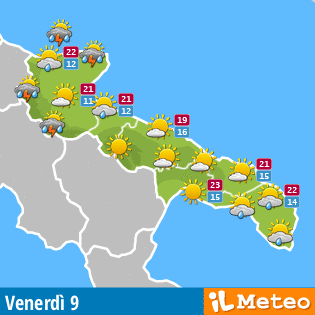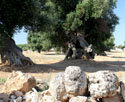Ancient villages
Suggestive villages to be discovered
Ancient maritime centres alternate with others characterized by lime painted buildings and narrow alleys awakening the tourist’s curiosity, without forgetting the typical cone-form buildings called trulli, which have no equal in the world. Ancient cathedrals, little rocky churches, medieval castles, the magnificence of the Baroque of Lecce: these are some of the marvels offered by an historical, artistic and cultural patrimony which arouses lively interest.
Alberobello, a set of Trulli which became a U.N.E.S.C.O. World Heritage Site
Alberobello is a really singular city thanks to its trulli, which are famous all over the world. They are dry-stone buildings characterized by white lime walls and grey stones used to realize the typical cone-form roofs. The town expands on two hills; the first lies east and includes the modern part of the city; the second lies west and there we find the quarters Monti and Aia Piccola, which represent the monumental area marked by the trulli.
Bari is the largest and economically most important city on the Adriatic sea
The city of Bari is the chieftown of Apulia and it appears as a very rich and dynamic town. It is the ninth most-populated city in Italy and the third most important city of Southern Italy after Naples and Palermo. It was founded by Illyrians and then became a roman city being a strategic centre on the Via Traiana; subsequently it was under the dominance of Longobards, Arabians and Bizantynes until the Norman conquest.
Cisternino, a total white village surrounded by alleys, arches, stairs and balconies full of flowers
It is easy to get lost in the centre of this total white village, in a network of alleys, arches, stairs and balconies full of flowers, which is the result of the spontaneous architecture marking this town. The village overlooks the Valle d’Itria or Valle dei Trulli from a wonderful balcony and it is mentioned in the list of the most beautiful towns in Italy.
Conversano, a medieval village on the Murge
Conversano, with its little medieval suburb, lies on the first hills of the Murge; it was already peopled during the Prehistoric Age by Peuceti and Japigi and it is possible to find an evidence of their passage in the ruins of the megalithic walls surrounding the ancient Norba, which can be perfectly admired near the abbey of San Benedetto and at the base of the main tower of the castle.
The enchanting old town centre of Gallipoli standing on an island
Kalé polis, the beautiful city. This is the name the Greeks gave it. Gallipoli is sited along the west coast of the Salento peninsula; it overlooks the Ionian sea and appears divided into two different parts that is to say the suburb and the old town centre, which are bound together by a 17th - century stone bridge with seven spans.
Lecce, the city of Baroque
Lecce, the city of Baroque, is famous all over the world thanks to its really valuable Baroque which is its distinguishing mark; its splendour is due to the intuition of emperor Carlo V, who provided the city with new defensive structures against the Turks and promoted the artistic development which made the city win the name Firenze del Sud (“the Florence of southern Italy”).
Locorotondo, a village immersed in the beautiful Valle d’Itria
It is a village standing on the top of an hill in the beautiful Valle d’Itria. It is possible to admire the view from the municipal villa but it is also interesting to venture in the narrow alleys of the suburb and admire the ancient buildings made of white lime. The name of the town comes from the concentric position of its streets.
Martina Franca, one of the most elegant city in Apulia
One of the most elegant city in Apulia, close to the south-eastern area of the Murge, Martina Franca appears as an ancient town marked by narrow alleys and popular courtyards, where it is beautiful to venture and admire the beauties of its Baroque. The elegance of its architecture makes the city precious; the Baroque style is everywhere: in the palaces, the portals, the windows, the balconies and their railings.
Monopoli and its suggestive and lively old town centre
Situated on the sea and surrounded by old Messapic walls which date back to the 5th century B.C., Monopoli is one of the most important ports in the Adriatic sea and it is characterized by a very lively old town centre. With its suggestive and characteristic atmosphere, it dates back to Early Middle Ages; it was built on the ruins of an important Messapic town.
The old town centre of Monte Sant'Angelo develops around the Archangel’s cave
Monte Sant’Angelo stands on a 800 metres high rocky spur of the Gargano and it is a U.N.E.S.C.O. World Heritage Site; it develops in the 5th century A.D. and it is indissolubly linked with the cult of Saint Michael, the Archangel
Ostuni, the white town kissed by the sun
Ostuni, famous as the “white town” because of its bright white lime walls, stands on an hill which dominates the sea, at the end of the southern Murgia. It is beautiful with its white little houses, the courtyards and the alleys surrounded by ancient walls with Aragonese towers.
Otranto, the most eastern city of Italy. Great charm and ancient origins
It is the most eastern city of Italy, with extraordinary charm and ancient origins. The area of Otranto was probably already peopled during the Paleolithic age. Subsequently it was inhabitated by Messapi, Greeks and Normans.
Peschici, a characteristic old town centre on a promontory
Peschici was founded around the year one thousand, when Dalmatians and Schiavoni settled here to stem Saracen raids. It shows a characteristic old town centre, on a 90 metres high promontory falling sheer to the sea (indeed the name of the town means “cliff that falls sheer to the sea”); it is possible to admire the white single-storey houses and the dome-shaped roofs following the Arabian style.
Polignano a Mare stands on a cliff falling sheer to the Adriatic sea
On the top of a cliff that falls sheer to the sea being 24 metres high in the highest point, stands the old town of Polignano, where the coast is characterized by erosive phenonema and inlets. It has Greek origins but some scholars assert that it was already peopled during the prehistoric age. Some evidences could be the settlement of Santa Barbara and the adjacent hypogeum Manfredi.
Trani, a casket full of historical, artistic, religious and cultural treasures
Trani surely represents one of the most beautiful destinations of our Region, a casket full of historical, artistic, religious and cultural treasures. It is famous not only for its wonderful cathedral, on the sea, but also for the imposing castle and the elegant town.
Tremiti islands, an archipelago of uncontaminated nature
It is an archipelago of uncontaminated nature, 22 km out to the coast of Gargano, which is formed by three main islands: San Nicola, San Domino and Capraia, to which we add the little island of Cretaccio and the farther Pianosa. These islands are also called Diomedee because the myth says that, after the Trojan war, the hero Diomede had been buried exactly here.
Vieste, a charming medieval village
The town of Vieste is the main centre of the Gargano; it is particularly famous for its beautiful waters thanks to which the city received the “bandiera blu” many times. The old town centre is really charming: it is characterized by typical white houses and narrow alleys leading to little squares.

 Home PUGLIA
Home PUGLIA Places to visit
Places to visit Sea places
Sea places Ancient villages
Ancient villages Salento
Salento Gargano
Gargano Tremiti Islands
Tremiti Islands Valle D'Itria
Valle D'Itria Lecce Baroque
Lecce Baroque Holy sites
Holy sites Olive groves
Olive groves Sitemap
Sitemap































